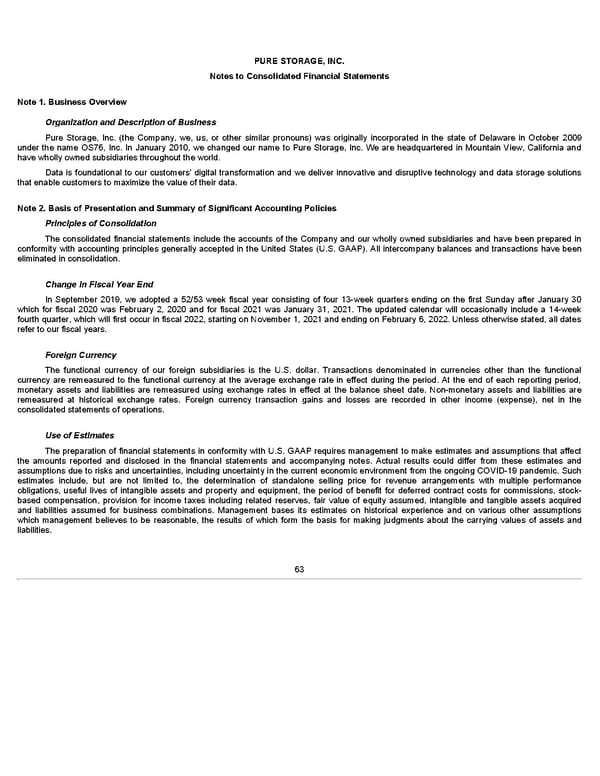PURE STORAGE, INC. Notes to Consolidated Financial Statements Note 1. Business Overview Organization and Description of Business Pure Storage, Inc. (the Company, we, us, or other similar pronouns) was originally incorporated in the state of Delaware in October 2009 under the name OS76, Inc. In January 2010, we changed our name to Pure Storage, Inc. We are headquartered in Mountain View, California and have wholly owned subsidiaries throughout the world. Data is foundational to our customers' digital transformation and we deliver innovative and disruptive technology and data storage solutions that enable customers to maximize the value of their data. Note 2. Basis of Presentation and Summary of Significant Accounting Policies Principles of Consolidation The consolidated financial statements include the accounts of the Company and our wholly owned subsidiaries and have been prepared in conformity with accounting principles generally accepted in the United States (U.S. GAAP). All intercompany balances and transactions have been eliminated in consolidation. Change in Fiscal Year End In September 2019, we adopted a 52/53 week fiscal year consisting of four 13-week quarters ending on the first Sunday after January 30 which for fiscal 2020 was February 2, 2020 and for fiscal 2021 was January 31, 2021. The updated calendar will occasionally include a 14-week fourth quarter, which will first occur in fiscal 2022, starting on November 1, 2021 and ending on February 6, 2022. Unless otherwise stated, all dates refer to our fiscal years. Foreign Currency The functional currency of our foreign subsidiaries is the U.S. dollar. Transactions denominated in currencies other than the functional currency are remeasured to the functional currency at the average exchange rate in effect during the period. At the end of each reporting period, monetary assets and liabilities are remeasured using exchange rates in effect at the balance sheet date. Non-monetary assets and liabilities are remeasured at historical exchange rates. Foreign currency transaction gains and losses are recorded in other income (expense), net in the consolidated statements of operations. Use of Estimates The preparation of financial statements in conformity with U.S. GAAP requires management to make estimates and assumptions that affect the amounts reported and disclosed in the financial statements and accompanying notes. Actual results could differ from these estimates and assumptions due to risks and uncertainties, including uncertainty in the current economic environment from the ongoing COVID-19 pandemic. Such estimates include, but are not limited to, the determination of standalone selling price for revenue arrangements with multiple performance obligations, useful lives of intangible assets and property and equipment, the period of benefit for deferred contract costs for commissions, stock- based compensation, provision for income taxes including related reserves, fair value of equity assumed, intangible and tangible assets acquired and liabilities assumed for business combinations. Management bases its estimates on historical experience and on various other assumptions which management believes to be reasonable, the results of which form the basis for making judgments about the carrying values of assets and liabilities. 63
 Annua lReport Page 62 Page 64
Annua lReport Page 62 Page 64